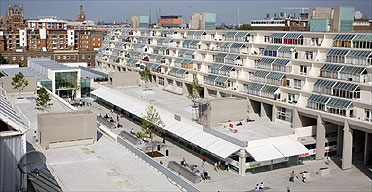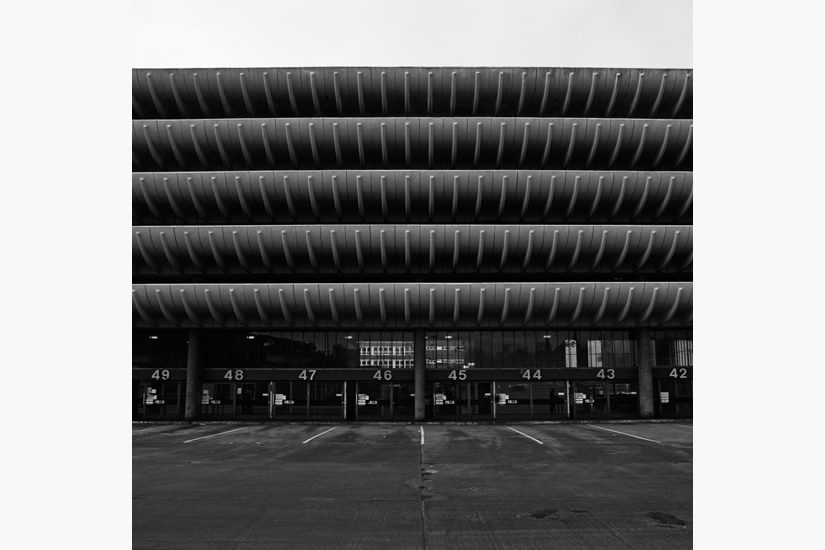The Brunswick centre was built in the late 1960's as a mixed development with an open shopping precinct complete with cinema and residential accommodation above. Located in the heart of Georgian Bloomsbury replacing rows of Georgian houses which still surround the site the building (in true brutalist tradition) makes very little attempt to integrate itself with its historic surroundings and as a result is inevitably controversial (in true brutalist tradition).
Leslie Martin's practice was commissioned to prepare designs for the site with most of the design attributed to Patrick hodgkinson who was then working in the practice. A relatively unknown architect who design few buildings outside Oxford and Cambridge and none of the size and scale of the Brunswick centre. The scheme was the brainchild of a private property developer looking to make a quick profit with the original intention of constructing a series of high density high-rise blocks for private residential accommodation. However the then restrictions on height of buildings in London by the LCC (London County Council) led to a radical rethink in the design. The building as built still allows for high density whilst falling within the then rigid height restrictions being built as two long high dense blocks with the space between used for shops and commercial activities.
However, even before competition the scheme quickly fell into trouble as it failed to find enough private tenants to make the scheme viable, the result of which was to lease the accommodation to Camden council for social housing, the process inevitably led to cut backs in the quality of the finish (the building was intended to be painted which was only achieved after the most recent restoration in the early 2000's). After completion the scheme was widely regarded as a failure with many of the shops unoccupied and retailers staying away. Although despite its failure in this regard it has since the time of opening in 1972 retained an independent (less so after a recent take over) cinema (the 'Renoir' currently undergoing refurbishment until Dec 2014 see below) specialising in foreign films.
 The sense of failure associated with the project and the general distaste and disillusion in which the monumental scheme was viewed made it look like demolition was only a matter of time. However, the building became one of the first brutalist modern buildings to be listed in 2000 by English Heritage and has since been restored and modernized along the lines of the original intentions of the scheme (such as a lick of paint) which were finally being realized.
The sense of failure associated with the project and the general distaste and disillusion in which the monumental scheme was viewed made it look like demolition was only a matter of time. However, the building became one of the first brutalist modern buildings to be listed in 2000 by English Heritage and has since been restored and modernized along the lines of the original intentions of the scheme (such as a lick of paint) which were finally being realized.
The most important change has been with the shopping precinct which has undergone a significant rejuvenation with the introduction of many high-street chains (including a Waitrose supermarket) which has established the areas identity as a retail destination and has more successfully integrated the building with the surrounding Georgian streets. The social mix of the residents has also changed (although not as much as in some areas) with an increasing number of professional types in privately owned flats, although like many areas of London it has (at the current time of writing) a healthy mix of residents which gives the city much of its character.
 The design of the building is radically different to that of its first design in which brick would have been used instead of the current monolithic use of concrete (this was primarily down to cost, a concession made in the acknowledgement that concrete would be painted - which it was not until recently) which would have given the building a quite different appearance.
The design of the building is radically different to that of its first design in which brick would have been used instead of the current monolithic use of concrete (this was primarily down to cost, a concession made in the acknowledgement that concrete would be painted - which it was not until recently) which would have given the building a quite different appearance.
The eight pairs of ventilation towers are the main point of attention of the building which captures the eye, they are clearly in the brutalist tradition of utilitarianism in which the most striking feature is also entirely practical (practical use of ventilating the building as well as a striking architectural feature of the building. The estate also has a stepped design (also seen in the Alexander road estate for Camden) giving it the distinctive futuristic appearance (or the 1960's idea of what futuristic would look like) which is also entirely practical by allowing the maximum amount of sunlight to reach each flat and allowing the central shopping precinct to be open and light.

The Brunswick centre looking North with St Pancras station (from the Guardian article)
Leslie Martin's practice was commissioned to prepare designs for the site with most of the design attributed to Patrick hodgkinson who was then working in the practice. A relatively unknown architect who design few buildings outside Oxford and Cambridge and none of the size and scale of the Brunswick centre. The scheme was the brainchild of a private property developer looking to make a quick profit with the original intention of constructing a series of high density high-rise blocks for private residential accommodation. However the then restrictions on height of buildings in London by the LCC (London County Council) led to a radical rethink in the design. The building as built still allows for high density whilst falling within the then rigid height restrictions being built as two long high dense blocks with the space between used for shops and commercial activities.
However, even before competition the scheme quickly fell into trouble as it failed to find enough private tenants to make the scheme viable, the result of which was to lease the accommodation to Camden council for social housing, the process inevitably led to cut backs in the quality of the finish (the building was intended to be painted which was only achieved after the most recent restoration in the early 2000's). After completion the scheme was widely regarded as a failure with many of the shops unoccupied and retailers staying away. Although despite its failure in this regard it has since the time of opening in 1972 retained an independent (less so after a recent take over) cinema (the 'Renoir' currently undergoing refurbishment until Dec 2014 see below) specialising in foreign films.
 The sense of failure associated with the project and the general distaste and disillusion in which the monumental scheme was viewed made it look like demolition was only a matter of time. However, the building became one of the first brutalist modern buildings to be listed in 2000 by English Heritage and has since been restored and modernized along the lines of the original intentions of the scheme (such as a lick of paint) which were finally being realized.
The sense of failure associated with the project and the general distaste and disillusion in which the monumental scheme was viewed made it look like demolition was only a matter of time. However, the building became one of the first brutalist modern buildings to be listed in 2000 by English Heritage and has since been restored and modernized along the lines of the original intentions of the scheme (such as a lick of paint) which were finally being realized. The most important change has been with the shopping precinct which has undergone a significant rejuvenation with the introduction of many high-street chains (including a Waitrose supermarket) which has established the areas identity as a retail destination and has more successfully integrated the building with the surrounding Georgian streets. The social mix of the residents has also changed (although not as much as in some areas) with an increasing number of professional types in privately owned flats, although like many areas of London it has (at the current time of writing) a healthy mix of residents which gives the city much of its character.
 The design of the building is radically different to that of its first design in which brick would have been used instead of the current monolithic use of concrete (this was primarily down to cost, a concession made in the acknowledgement that concrete would be painted - which it was not until recently) which would have given the building a quite different appearance.
The design of the building is radically different to that of its first design in which brick would have been used instead of the current monolithic use of concrete (this was primarily down to cost, a concession made in the acknowledgement that concrete would be painted - which it was not until recently) which would have given the building a quite different appearance. The eight pairs of ventilation towers are the main point of attention of the building which captures the eye, they are clearly in the brutalist tradition of utilitarianism in which the most striking feature is also entirely practical (practical use of ventilating the building as well as a striking architectural feature of the building. The estate also has a stepped design (also seen in the Alexander road estate for Camden) giving it the distinctive futuristic appearance (or the 1960's idea of what futuristic would look like) which is also entirely practical by allowing the maximum amount of sunlight to reach each flat and allowing the central shopping precinct to be open and light.

The Brunswick centre looking North with St Pancras station (from the Guardian article)

















